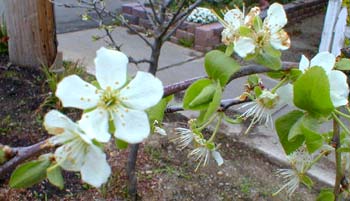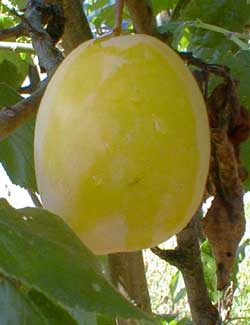
Semi-Dwarf Yellow Egg
aka, Pershore Egg
European Plum
"Pure white plum blossoms
slowly begin to turn
the color of dawn
-Yosa Buson,
1716-1784
1716-1784
I obtained semi-dwarf 'Yellow Egg' as a cross-pollinator for semi-dwarf 'Italian Plum' so that they might co-habit in a low-maintenance roadside sun-garden. 'Yellow Plum' is very self-fertile, but allegedly any plum can produce even better with a second variety of plum nearby. It's certainly not essential, however, not like it is for sweet cherries or apples. And despite the often-stated idea that even self-fertile fruit trees produce more fruit with a second variety nearby, I've seen both 'Yellow Plum' & 'Italian Plum' growing in small stands of only one or the other, & the limbs so laden with fruit it would be ridiculous to suppose a second cultivar could increase that.
 Still, I wanted these two plums for their ornamental appearance. I thought having one tree with yellow plums & another with purple-blue plums would be visually charming.
Still, I wanted these two plums for their ornamental appearance. I thought having one tree with yellow plums & another with purple-blue plums would be visually charming.'Yellow Egg' is known especially in England as 'Pershore Egg' or 'Pershore Yellow Egg," named for a town near Evesham in the County of Worcestershire where it was first developed.
Their main purpose for us is to provide the bones of a sun-garden, as I have begun to surround these little fruit trees with low-maintenance shrubs & drought-hardy perennials. We first gave considerable thought to "merely" ornamental trees that would never have edible fruits, but decided what the heck, why not go for the fruits too.
Both trees were obtained as small inexpensive pre-spring bareroots. As they're on the street where it is not easy to irrigate regularly, I have relied on their hardiness in most zones & most conditions. Because not cared for to any particular degree, they haven't grown rapidly, & the Yellow Egg didn't fruit until its third year. But both have at least flowered well, the Yellow Egg ahead of the blue Italian Prune. I will be trying to get water out to them on a better schedule, since they've been nicely pruned for good stature, & I want to encourage a burst of growth, as well as better fruiting.
 The two trees have overlapping flowers in late March & early April, but 'Yellow Egg' starts soonest before mid-March. The blooms do not last long, but leaves are coming in before the flowers are entirely spent.
The two trees have overlapping flowers in late March & early April, but 'Yellow Egg' starts soonest before mid-March. The blooms do not last long, but leaves are coming in before the flowers are entirely spent.Fruits ripen in mid-August, & our relatively short summers never stops prunes from entirely ripening. Being by the street, kids can harvest them on the way to school, but that's fine, just so long as Granny Artemis & I get some too.
 Yellow Egg is frequently regarded only a cooking plum, but this is a serious error. It is true that when they are picked not-fully-ripened so that they will be tough enough to ship to markets without mushing & bruising, the unripe plum is tart.
Yellow Egg is frequently regarded only a cooking plum, but this is a serious error. It is true that when they are picked not-fully-ripened so that they will be tough enough to ship to markets without mushing & bruising, the unripe plum is tart.Though it will soften as it ages, it won't be any sweeter, so store-bought Yellow Eggs are mostly good only for cooking. But left on the tree to ripen, it is very sweet, & the skin no longer tough. It cannot be shipped to market as a tree-ripened fruit because by then it is very soft & will not keep fresh for any length of time, so the only chance to taste this perfectly lucious fruit is to have access to a tree.
The blue Italian Plum by comparison is sweeter sooner, so when picked early (to be tough enough to ship) it still tastes pretty good, though nothing like when it too is harvested ripe from the tree. When both plums are tasted fresh & fully ripe, I find the yellow to be moister with better flavor, but certainly not all trees produce fruits of the exact same flavor, so it can vary from tree to tree.
The origin of the Prunus domesticus is a little uncertain, but it is believed to have originated less than 2,000 years ago on the Caspian Sea side of the Caucasus Mountains. It was a spontaneous hybrid of the diploid P. cerasifera with the tetraploid P. spinosa resulting in the hexaploid plum trees now generally called P. domesticus.
Also called 'Pelshore Yellow Egg,' this variety is very widely cultivated in the Northwest. 'Pelshore' began as a single tree discovered as a seedling in the Tiddesley Woods, Vale of Evesham, dug up to moved to a Worcestershire orchard circa 1827. It proved so productive that over time it became the most commonly grown yellow plum, with other varieties mostly descended from 'Pelshore.'
The Vale of Evesham was for two centuries or longer a famous plum growers' center in England & even today the Vale boasts a half-dozen growers of consequence, though that is a fraction of the numbers of growers that once were. Sadly, so recently as the 1980s & 1990s, the majority of those growers who once made the Vale a fruiting paradise gave up their orchards due to changing economics & the government's unwillingness to assist in the wake of a growers' crisis caused by two tree-killing extreme winters.
As the orchards were abandoned, heirloom varieties of plums were subsequently lost, though most of the important ones are now grown on the European continent & in North America. Certainly the popular 'Yellow Egg' has never been at risk of disappearing.